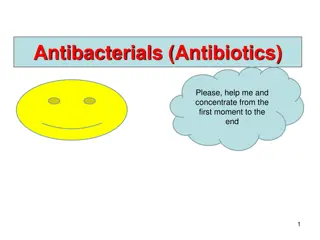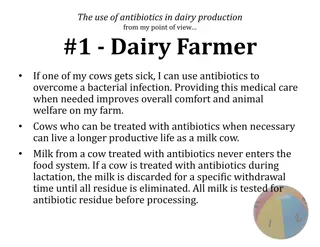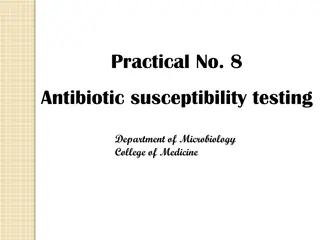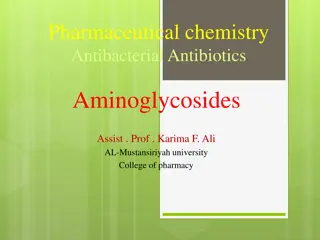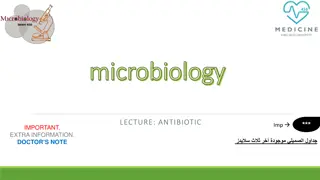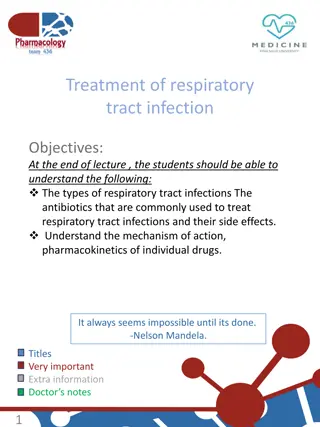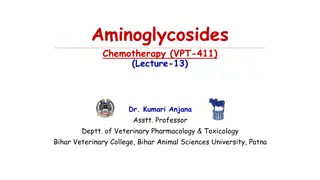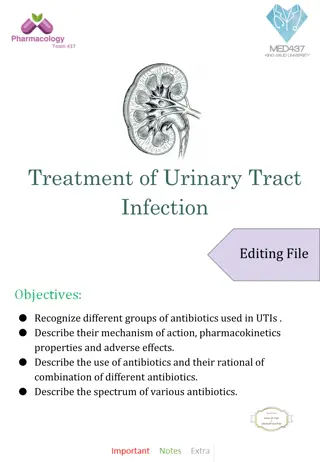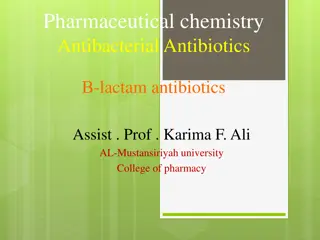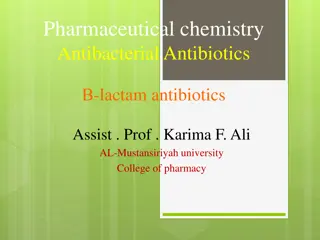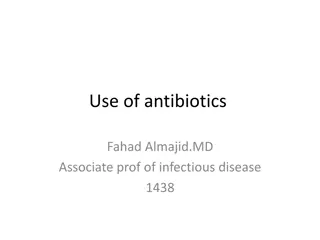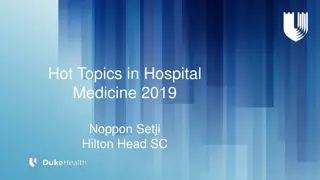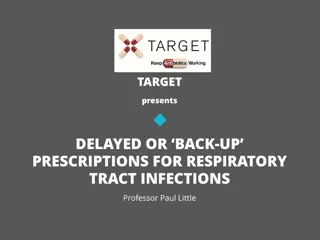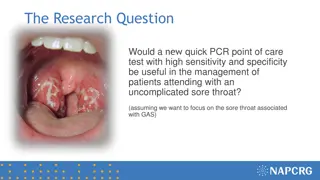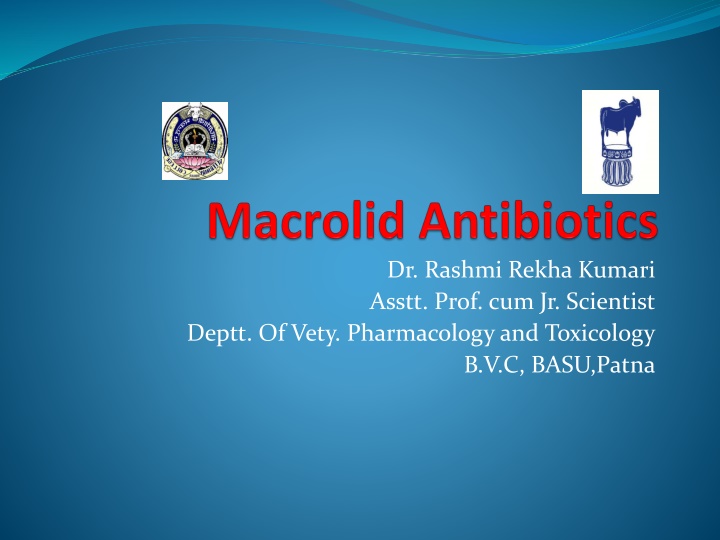
Macrolide Antibiotics and Their Mechanism of Action
Explore the world of macrolide antibiotics, including erythromycin and newer semi-synthetic variants, their antibacterial spectrum, mechanism of action, and resistance in Gram-positive bacteria. Learn about the role of these antibiotics in combating bacterial infections effectively.
Download Presentation

Please find below an Image/Link to download the presentation.
The content on the website is provided AS IS for your information and personal use only. It may not be sold, licensed, or shared on other websites without obtaining consent from the author. If you encounter any issues during the download, it is possible that the publisher has removed the file from their server.
You are allowed to download the files provided on this website for personal or commercial use, subject to the condition that they are used lawfully. All files are the property of their respective owners.
The content on the website is provided AS IS for your information and personal use only. It may not be sold, licensed, or shared on other websites without obtaining consent from the author.
E N D
Presentation Transcript
Dr. Rashmi Rekha Kumari Asstt. Prof. cum Jr. Scientist Deptt. Of Vety. Pharmacology and Toxicology B.V.C, BASU,Patna
Macrolide lactone ring to which one or more deoxy sugars are attached. The clinically important members of this groupare: antibiotics contain many membered Class troleandomycin. They havea 14 membered ring. . I: Erythromycin, oleandomycin, and
Class II: Spiramycin, josamycin, tilmicosin and tylosin. These are having a 16membered ring Recently some newer semisynthetic macrolides (Roxithromycin, clarithromycin and azithromycin) have been developed and used in man and small animals as an alternative to erythromycin.
Erythromycin It is the prototype drug of this group Erythromycin wasobtained from Streptomyceserythreus in 1952 Antibacterial spectrum: effectiveagainst mostaerobic Gram positive bacteria. In general, macrolides are narrow spectrum antibiotic and do not effective against Gram negative bacteria although some strains of Pasteurella, Haemophilus and Neisseria sppare moderatelysensitive Macrolides are mainly
Antibacterial spectrum They are also effective against Mycoplasma, Chlamydia and Ricketssiae spp, but not against protozoa and fungi. Tilmicosin is a broad spectrum macrolideand has exceptionally high activity against Pasteurella haemolyticaand P .multocida. Some of the members are also active against Mycobacterium
Mechanism of action All the macrolide are bacteriostatic antibiotic and have similar mechanism of action . The act by inhibiting the bacterial protein synthesis in susceptible organism. They bind with the 50 S bacterial ribosomal subunit and interfere with translocation of nascent elongated peptide chain at the acceptor (A) site back to the peptidyl (P) site required to make the A site available for next aminoacyl tRNA attachement .
This results in failure of ribosome to move along the mRNA to expose the next codon, premature termination of peptide chain and ultimately suppression of protein synthesis. Macrolide should not be administered with chloramphenicol and lincosamides as they may compete for binding to the same 50S ribosomal subunit. Resistance to macrolide in Gram positive bacteria
Pharmacokinetics and Administration Erythromycin base is destroyed by gastric acid. Macrolides are readily absorbed from the GI tract if it is administered orally as acid resistant salts (stearate,estolate,lactobionate) or as tablets with acid resistant coating . The absorption from rumen is very slow and unreliable Erythromycin and tylosin are rapidly absorbed following IM administration. Tilmicosin is administered SC. Macrolides are widely distributed into the most tissues (practically in lungs) and fluids but not the CSF unless the members are inflamed .
Diffusion also occurs through the peritoneal and pleural cavities and placenta. The drugs undergo 70-80% plasma protein binding . They concentrate in bile and milk . Following oral administration they are mainly metabolized in liver, excreted mainly in bile and undergoenterohepaticcycling. After parenteral administration the drugs are mainly excreted through urine.
Side effects and Toxicity In general, macrolides are least toxic antibiotic but tilmicosin is comparatively toxic. They are irritants and may cause pain and swelling at the site of injections Erythromycin estolate salt is particularly hepatotoxicand may cause cholestatic jaundice. Hypersensitivity reaction or skin reactions may occasionally be seen. High doses may cause severe GI disturbances (vomiting, diarrhea, odema, of GI mucosa etc.) Horses are particularly highly sensitive and may suffer from serious and even fatal GI disturbances. Tylosin in dog causes tachycardia and decreased the cardiac contractility and it is contraindicated in pigs.
Clinical uses Macrolides are used as alternative to penicillin G in Gram positive infections (Particularly in patient allergic to penicillin), In respiratory tract infections In the treatment of atypical pneumonia caused by mycoplasma pneumoniae, Bronchopneumonia, Bacterial enteritis, Uinary tract infections, Bacterial pyodermatitis, Arthritis, Mastitis, Metritisand CRD in poultry.
Dosage: Erythromycin; Dog and cat: oral: 15 mg /kg three times of a day. Parenteral: IM, Cattle, horse, and dog, cat, pig:
Oleandomycin and Troleandomycin Oleandomycin is obtained from Streptomyces antibioticus. Troleandomycin is a derivative of oleandomycin. Both drugs possess erythromycin like antibacterial spectrum and have special activity against Staphylococci and Streptococci. Dose: Either drug is adm .orally @ 1.2- 2.2 mg/kg at 6 hr. intervals. In veterinary medicine, they are used in treatment of staphylococcal and streptococcal mastitis. Combination of ox tetracycline and oleandomycin in 2:1 ratio administered by IM or IV route strengthen the activity against Gram positive organism
Spiramycin Source: A strain of Streptomyces ambofaciens. Its antibacterial activity is also similar to erythromycin and oleandomycin. It attains a high concentration in body fluids (particularly pleural and peritoneal fluids): thus it is the drugs of choice in the treatment of contagious bovine pleuropneumonia @25mg /kg ,IM,3 injection at 48 hr. interval). It is also used for the treatment of toxoplasmosis in ewes (100mg/kg ,orally). Ovine rickettsia Keratoconjuntivitis (20-30 mg/kg, IM), CRD in poultry and swine dysentery caused by Treponema hyodysentriae.
Tylosin Source: A strain of Streptomyces fradiae. Its antibacterial spectrum is similarto erythromycin. Administration: Tylosin tartrate is administered in drinking water to chicken, turkeyand pigs and also SC to chickens . Tylosin phosphate is administered to pigs in feed. Tylosin base is administered IM to cattle, calves, pigs, dogs and cats. The clinical application of tylosin is as follows. Cattle: Pneumonia foot rot and metritis @ 10-20 mg/kg IM or onceor twice a days. Dog and cat: Respiratory and urinary tract infection, otitis externa, metritis, leptospirosis and check secondary bacterial infection in viral disease @ 10 mg /kg IM twice a day.
Tilmicosin: respiratory disease associated with pasteurella haemolytica. Dose: cattle: 10 mg/kg SC, single injection Withdrawal period for meat: cattle: 28 days, milk discarded time: cattle: 0, days. It is mainly used in the treatment of bovine Newer erythromycin viz penetration, gastric acid lability, low short half-life roxithromycin, clarithromycin and azithromycin have been developed Macrolides: To overcome the limitations of narrow spectrum activity, poor tissue oral bioavailability and some semisynthetic macrolides like
Their erythromycin Mycoplasma and Chlamydia. antibacterial spectrum some is similar more to that against of and are active They are mainly used in man and small animals as an alternative to erythromycin for respiratory tract infection, pneumonia, skin, soft tissueand genital tract infection.
LINCOSAMIDES These antibiotics closely resemble macrolideantibiotics in their antibacterial spectrum, mechanism of action and clinical application . The most important membranes of this group are lincomycin and clindamycin. LINCOMYCIN: It is produced by Streptomyces lincolnensis. The drug is active against Gram positive bacteria including penicillinase producing Streptococci, Clostridium tetani, Cl .perfringens, Erysipelothrix, Actinomycetes, Nocrdiaand certain strain of Mycoplasma pneumonia. Its most distinctive feature is it activity against a variety of anaerobes (Bacteroides fragilis) .However, aerobic Gram negative bacilli are not affected. lincosamidecan be administered orally, IM, or IV
Lincomycin is readily absorbed orally and completely absorbed from IM sites. The drug is widely distributed in the body incuding skeletal and soft tissues but cannot penetrate the blood brain barrier. It is largely metabolized in liver and the metabolites are excreted in urine and bile. Clinical uses: Because of serious toxic effect its use is restricted in infectious caused by susceptible Gram positive bacteria, particularly Staphylococci and Streptococci and for those by anaerobic pathogens
The drug is used in respiratory, skeletal, skin, joint and adjoining tissue infections in dogsand cats. It is also used to treat infectious arthritis in pigs (due to Streptococci, Staphylococci), Erysipelothrix and Mycoplasma and pneumonia in pigs due to Mycoplasma. Side Effectand Toxicity: Thesedrugs have no seriousorgan toxicity . GI disturbances may occurs major problem in man is super infection, diarrhoea, and pseudomembranous colitis (treated by vancomycin), caused by a toxin produced by Clostridium difficile, Hypersensitivity reactionand sketal muscle paralysis mayalsooccurs. Lincosamides are contraindicated in horses (because severe and fatal colitis may develop), and neonates (due to limited ability to metabolize the drugs).
CLINDAMYCIN It is semisyntheticderivative of lincomycin and differs chemically from lincomycin by substation of a chloride atom for a hydroxyl group. It is more potent than the parent compound. It is better than lincomycin and has reduced the incidence of adverse effect than lincomycin. The antibacterial spectrum and clinical application is similar to lincomycin. It has replaced lincomycin for anaerobic, skeletal, soft tissues and skin infection. Dose: Dogs: 5-10 mg/kg orally twice a daily.



